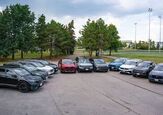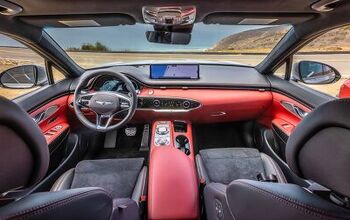2026 Hyundai Ioniq 9 is an EV Flagship with a Lounge-Like Cabin

Ahead of this year’s Los Angeles Auto Show, Hyundai has revealed the third Ioniq member, completing the family it first hinted at four years ago.
Originally previewed as the Seven concept in LA three years ago, the 2026 Hyundai Ioniq 9 is a true brand flagship: longer, wider, taller, and more powerful than anything else (without an N badge) that it will share showrooms with. Built upon the Hyundai group’s E-GMP platform, this three-row SUV sports Hyundai’s largest-capacity battery pack (110.3 kilowatt-hours), promising a range of well over 300 miles (483 kilometers) regardless of trim.
The Ioniq 9 design stays remarkably true to the original concept. Of course the show floor flights of fancy are gone—see ya later coach doors, wraparound sofa rear seats, and full glass liftgate—but the proportions and general design language remains. The brand’s Parametric Pixel lighting stretches across the nose, with adaptive capability to avoid glare for oncoming drivers. The lower bumper features a large swath of negative space flanked by two sets of vertical lighting elements, keeping the Ioniq family look while visually connecting the new model to the boxy Santa Fe.
In profile, the gentle arc of the roofline gives the Ioniq 9 an elegant look in comparison to its platform-mate the Kia EV9. A strong shoulder line starts from the middle of the rear door and progresses right to the liftgate, which features tall, fully LED taillights. A clever touch here is the wraparound effect of the high-mounted brake light. While the amount of glass is down from the concept, the liftgate still features a lot of window, which should make for good visibility. A range of wheels from 19 to 21 inches rounds out the look—which Hyundai insists is called “aerosthetic” but we’ll never say it again.
Despite the shape and size, the Ioniq 9 cuts through the air with a 0.259 coefficient of drag. Well, it will in other markets anyway: that impressive figure comes courtesy of digital side mirrors, which we won’t get in North America. A contributing factor is the complete removal of exterior antennae; Hyundai has divided the functions across the windshield, instrument panel, and tailgate glass instead.
The sofa might be gone, but the Ioniq 9 cabin is still very much geared towards a lounge feel. As is the case in the other Ioniq models, the cabin is chock-full of rounded shapes, from the big curve of the door panels, the rounded handles, and the semi-recessed dashboard design. A flat floor and large panoramic glass roof contribute to the lounge feel. Hyundai’s full-recline Relaxation Seats are here in both the front and second rows, and now include a Dynamic Touch Massage function. The second row perches can also swivel—only when the vehicle is stationary, of course—allowing middle-row occupants to face their friends in the third row. The advantages of an EV platform and the long wheelbase it provides are clear: second-row legroom is a huge 42.8 inches (1,087 millimeters), while the third row boasts 32.0 in (813 mm).
A sliding center console, dubbed Universal Island 2.0, moves 7.5 inches (190 mm) fore and aft, making it easier to pass along items between rows. Two levels of storage within provide over 18 liters of room for your various bits of family life. Staying on storage, there’s 21.9 cubic feet (620 liters) out back with the third row up, and 46.7 cu ft (1,323 L) with it down. There’s also a small frunk, up to 3.1 cu ft (88 L) for rear-drive models and shrinking to 1.8 cu ft (52 L) for AWD models.
Yes, like the other Ioniq models, the Ioniq 9 will be available with either rear- or all-wheel drive. Hyundai talks impressive efficiency figures for the (European WLTP) test cycle, expecting around 385 miles (620 km) of range. The North American estimate sits at a still-impressive 335 miles (539 km) with Long-Range RWD model on 19-inch wheels. This model’s single motor puts out 215 horsepower; the Long-Range AWD bumps the total output to 320 hp, while the Performance AWD produces 430 hp. The latter model is capable of sprinting to 62 mph (100 km/h) in 5.2 seconds. Hyundai says the Ioniq 9 can charge from 10 to 80 percent SoC in 24 minutes under ideal conditions with a DC fast charger.
Suspension duties fall to multi-link setups at both ends, with a MacPherson setup up front and self-levelling dampers out back. Towing is capped at 5,000 lb in North America, with a dedicated towing mode that locks the torque split to an even 50:50. There’s also a Terrain Traction Control System for off-tarmac use… and an AI-powered Auto Terrain Mode which will reportedly “recognize the road surface and select the optimal driving mode.” We look forward to testing that (in a controlled environment, of course).
As you’d expect, there’s a veritable Alphabet Soup of driver assists as standard. There’s other tech goodies too, from a UV-C sterilizer, an improved voice assistant, and the combination of 12.0-inch instrument cluster with a same-size touchscreen. The vehicle-to-load (V2L) capability of other E-GMPs is present here, and it will be capable of vehicle-to-home charging in the future.
Hyundai hasn’t resisted the lure of post-purchase, er, purchases, introducing what it calls Features on Demand (FoD). This includes not only ambient lighting or exterior lighting walk-up patterns, but also Amazon Music and Soundcloud streaming.
The 2026 Hyundai Ioniq 9 will arrive in North American dealerships in the first half of next year. Expect more details in the near future.
Become an AutoGuide insider. Get the latest from the automotive world first by subscribing to our newsletter here.

Kyle began his automotive obsession before he even started school, courtesy of a remote control Porsche and various LEGO sets. He later studied advertising and graphic design at Humber College, which led him to writing about cars (both real and digital). He is now a proud member of the Automobile Journalists Association of Canada (AJAC), where he was the Journalist of the Year runner-up for 2021.
More by Kyle Patrick





































Comments
Join the conversation